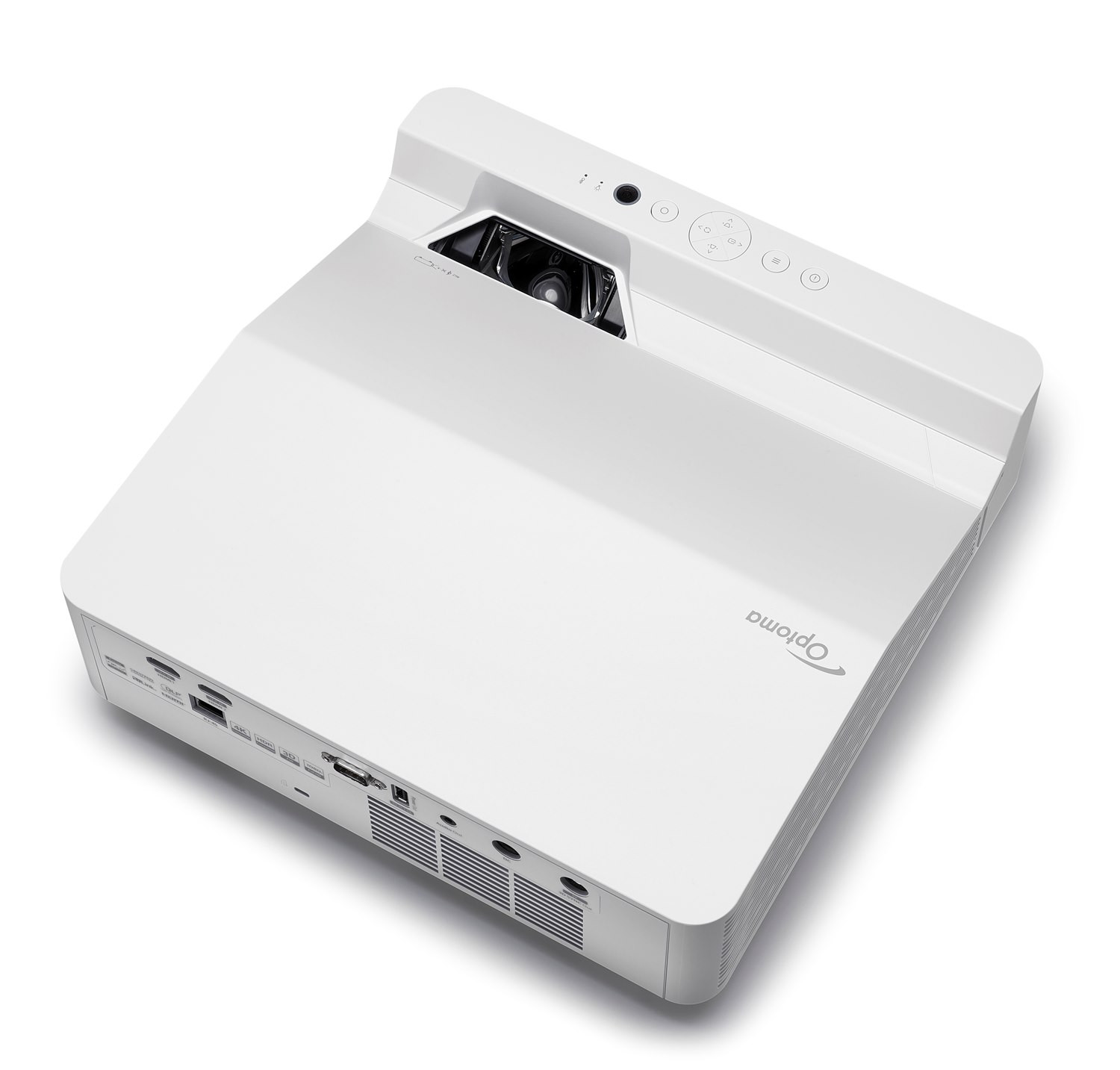



























£1,436.30*
- Brightness 3,800 Lumen
- Resolution 1920 x 1080 Full HD
- Aspect Ratio 16:9
- Operating noise 34 dB


Frequently purchased together
Product information
Environmentally friendly ultra-short throw laser home projector
The GT3500HDR is one of Optoma's most compact and hassle-free Full HD 1080p DuraCore laser projectors. Designed for maintenance-free continuous operation, this bright 3800 lumen projector can be used at any time of day for live sports, TV shows, games and movies with the lights on.
The GT3500HDR delivers powerful image performance with flexible installation features and extensive connectivity options in a slim, compact form factor that is up to 34% smaller than previous Optoma models.
In support of Optoma's commitment to sustainability, the GT3500HDR reduces power consumption by up to 45% compared to Optoma's lamp-based projectors. The energy-saving DuraCore laser technology ensures a long product life of up to 30,000 hours without the need for additional lamps, requires minimal maintenance and is mercury-free, further reducing the carbon footprint.
An additional benefit is that the GT3500HDR has an external power supply, which offers greater reliability, mobility and energy efficiency.
Full HD 1080p laser projector
Bright 3800 lumens
Ultra-short throw lens
100-inch image from less than half a metre away
Lit display
Enjoy live sports, TV shows, games and movies in full 1080p resolution
Designed for a competitive edge in gaming - Supports 1080p 120Hz at 8.6ms and 1080p 60Hz at 17ms
Light to see
This all-round home entertainment projector combines high brightness and brilliant colours for vivid, true-to-life images in well-lit environments - ideal for watching TV, sports and movies or playing games with family and friends at any time of day.

Ultra Short Throw
With an Ultra Short Throw lens, you can project an impressive image of over 100" from less than one metre away from the projection surface. This allows you to place the projector closer to the wall and reduce shadows - ideal for interactive applications.
Four-corner correction
Four-corner correction allows you to adjust the projector's keystone distortion in both the vertical and horizontal planes, so that each corner of the projected image can be individually distorted to make it perfectly square. Ideal for uneven walls or in rooms where the projector is awkwardly placed or restricted and needs to be set up at an angle.

360° projection
With 360° projection, images can be displayed in any orientation, giving you the freedom and versatility to set up the projector in any location.
Two HDMI inputs
Play games, stream videos and show photos on the big screen from the comfort of your own home. Thanks to the two HDMI inputs, you can easily connect your games console, set-top box, laptop, PC, Blu-ray player or media streamer with just one cable. You can even turn it into a smart projector by connecting an HDMI dongle such as Google Chromecast™, Amazon Fire TV, Apple TV™ or Roku® Stick.
USB power supply
Use the USB-A port to power external devices (5V/1.5A)
Automatic power off
It may happen that the projector remains switched on when it is not in use. To save energy, the "Auto Power Off" function automatically switches off the projector after a certain period of time when it is not in use.
HDR and HLG compatible
It can receive and display both HDR10 and Hybrid Log Gamma (HLG) HDR content. With this Optoma projector, you can see much more details and textures. Objects look more solid and realistic, and the extra detail gives a greater sense of depth.
Technical data
| Name | Optoma GT3500HDR Projector, 1920 x 1080 Full HD, 3800 Lumen |
|---|---|
| Article number | 1000031674 |
| GTIN/EAN | 5055387668102 |
| Manufacturer SKU | E9PD7M601EZ4 |
| Lens included | Yes |
| Model name | GT3500HDR |
| Projection Distance | Ultra Short Throw |
| Brand | Optoma |
| Product Type | Projector |
| Product Series | Optoma GT Series |
| Application | Home cinema projector |
| Projector Type | DLP |
| Projector lamp type | Laser |
| ANSI Lumen | 3,800 ANSI Lumen |
| Resolution | 1920 x 1080 Full HD |
| Aspect Ratio | 16:9 |
| Contrast Ratio | 500,000 :1 |
| Operating noise | 34 dB |
| Operating noise - ECO | 27 dB |
| Lamp life | 30,000 Hour |
| run-time | 24/7 |
| Minimum Projection Distance | 20.2 cm |
| Maximum Projection Distance | 39.8 cm |
| Minimum Projection Ratio | 0.253 |
| Maximum Projection Ratio | 0.253 |
| Horizontal Keystone | 5% |
| Vertical Keystone | 5% |
| Inputs | 1x Ethernet , 1x RS232 , 1x USB-A , 2x HDMI |
| Outputs | 1x 3,5mm Jack |
| wireless technology | WLAN optional |
| Features | 360° projection , HDR , HLG , Integrated speaker |
| Product width | 32.7 cm |
| Product height | 10.9 cm |
| Product depth | 32.7 cm |
| Weight | 3.9 kg |
| Colour | White |
| Delivery contents | Batteries , Power cable , Remote control |
| Condition | New |
| Warranty | 24 Month |
| Warranty type | Bringin service Service and support information |
Projection distance calculator
Contact our experts for help!
Image size:
Format
Format
Product safety
| Person responsible for the EU |
|---|
| Optoma Deutschland GmbH |
| Am Nordpark 3 |
| 41069 Mönchengladbach |
| Germany |
| info@optoma.de |




